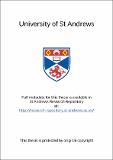Files in this item
Aesthetic unity in the works of St. Anselm of Canterbury
Item metadata
| dc.contributor.advisor | Hart, Trevor A. | en |
| dc.contributor.author | Hogg, David S, 1971- | en |
| dc.coverage.spatial | 330p | en |
| dc.date.accessioned | 2021-04-08T09:04:26Z | |
| dc.date.available | 2021-04-08T09:04:26Z | |
| dc.date.issued | 2000 | |
| dc.identifier.uri | https://hdl.handle.net/10023/22039 | |
| dc.description.abstract | It is usual to hold that there is no central theme in Anselm's writings because of the plethora of topics they address. Indeed, it may be argued that the occasional nature of what Anselm wrote warrants a certain discontinuity between each work. I propose, however, that if we seek to discern the model of reality that undergirds Anselm's writings, we will arrive at an understanding of that which unifies them. It seems to me that if we study Anselm's patterns of expression (both linguistic and ideological) we can better approximate the framework within which Anselm operated. In this way it is my hope that we can transcend the particularity of each treatise and begin to perceive the unity that underlies them all. What emerges from such a study is the pervasive presence of aesthetic categories. Now, it is true that aesthetic concerns have been noted by other scholars in parts of the Cur Deus Homo and the Prayers and Meditations, but aesthetics as a rubric under which to organise Anselm's thinking has yet to be explored. It is my contention that a return to the much neglected aesthetic aspect of the western medieval tradition is essential for any perlustration of Anselm's life and writings if we are properly to appreciate his contribution to that tradition. When, therefore, we take the time to perscrutate Anselm's writings, we discover just how pervasive is his profound appreciation for the proportion, symmetry, harmony, balance, order, and fittingness which are constituent of reality. This is the case, contends Anselm, because the creation is a reflection of the creator who is himself perfectly proportioned and ordered. The result is that we have the ability to attain some measure of comprehension of what transcends us because the reality we inhabit has been created in such a way that the immanent can relate to the transcendent, the finite to the infinite. Consequently, the particular questions Anselm answers, though maintaining their distinctiveness, are often viewed through the lens of aesthetic categories. | en |
| dc.language.iso | en | en |
| dc.publisher | University of St Andrews | en |
| dc.subject.lcc | BX4700.A58H7 | |
| dc.subject.lcsh | Anselm, Saint, Archbishop of Canterbury, 1033-1109 | en |
| dc.subject.lcsh | Aesthetics | en |
| dc.title | Aesthetic unity in the works of St. Anselm of Canterbury | en |
| dc.type | Thesis | en |
| dc.type.qualificationlevel | Doctoral | en |
| dc.type.qualificationname | PhD Doctor of Philosopy | en |
| dc.publisher.institution | The University of St Andrews | en |
This item appears in the following Collection(s)
Items in the St Andrews Research Repository are protected by copyright, with all rights reserved, unless otherwise indicated.

